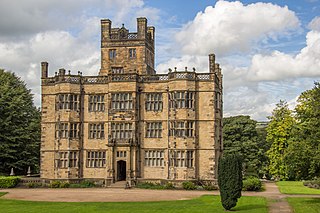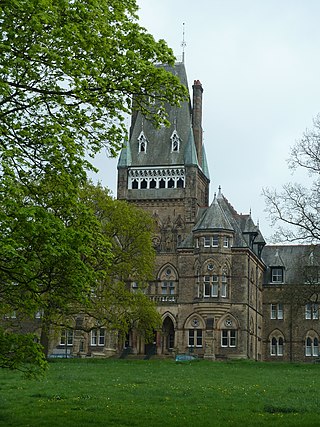
Capernwray Hall is a former country house situated 3 miles east-northeast of Carnforth, Lancashire, England, and is currently used as a Christian Bible school and holiday centre. The house is recorded in the National Heritage List for England as a designated Grade II* listed building. It stands in grounds included in the Register of Historic Parks and Gardens at Grade II.

Gawthorpe Hall is an Elizabethan country house on the banks of the River Calder, in Ightenhill, a civil parish in the Borough of Burnley, Lancashire, England. Its estate extends into Padiham, with the Stockbridge Drive entrance situated there. The house is traditionally attributed to Robert Smythson. In the mid-19th century, the hall was rebuilt by Charles Barry, the architect of the Houses of Parliament. Since 1953 it has been designated a Grade I listed building. In 1970 the 4th Lord Shuttleworth gave the hall to the National Trust, with a 99-year lease to Lancashire County Council. Both bodies jointly administer the hall and in 2015 the council provided £500,000 funding for restoration work on the south and west sides of the house.

Lytham Hall is an 18th-century Georgian country house in Lytham, Lancashire, 1 mile (1.6 km) from the centre of the town, in 78 acres (32 ha) of wooded parkland. It is recorded in the National Heritage List for England as a designated Grade I listed building, the only one in the Borough of Fylde.

Abbeystead House is a large country house to the east of the village of Abbeystead, Lancashire, England, some 12 km south-east of Lancaster. It is recorded in the National Heritage List for England as a designated Grade II listed building.
This is a list of Grade I listed buildings in Lancashire, England.

St Anne's Church is an active Anglican parish church located on Church Road in Singleton, Lancashire, England. It is in the deanery of Poulton, the archdeaconry of Lancaster, and the Diocese of Blackburn. Its benefice is united with those of St Chad, Poulton, and St Hilda, Carleton. It is recorded in the National Heritage List for England as a designated Grade II listed building.

Wennington Hall is a former country house in Wennington, a village in the City of Lancaster district in Lancashire, England. The house is a Grade II listed building and from 1940 until 2022 was used as a school, at first by the Quaker boarding school Wennington School before its move to Yorkshire, then by Lancashire County Council.

The Royal Albert Hospital was a hospital in Lancaster, Lancashire, England. It opened in 1870 as an institution for the care and education of children with learning problems. By 1909 there were 662 children in residence. Following new legislation in 1913, adults were also admitted. By the time of the introduction of the National Health Service in 1948 the hospital had 886 patients, and by the 1960s there were over 1,000 patients. Following legislation in the 1980s, the patients were relocated in the community, and the hospital closed in 1996. The building was acquired by Jamea Al Kauthar Islamic College to provide Islamic education for girls. The main part of the hospital is recorded in the National Heritage List for England as a designated Grade II* listed building, and its west lodge is listed at Grade II.

Ashton Hall is a largely rebuilt 14th-century mansion in the civil parish of Thurnham, Lancashire, England. It is 3 miles (4.8 km) south of the city of Lancaster and is on the east bank of the River Lune. It is recorded in the National Heritage List for England as a Grade I listed building, and is now owned by Lancaster Golf Club.

Lancashire is a county in North West England. In 1974 parts of the historic county were divided between Greater Manchester, Merseyside, Cheshire and Cumbria, and part of the West Riding of Yorkshire was transferred into the county, creating the non-metropolitan county of Lancashire. Together with the unitary authorities of Blackburn with Darwen and Blackpool it now forms the ceremonial county of Lancashire.
James Hibbert was an English architect who practised in Preston, Lancashire.
Claughton is a civil parish in the Lancaster district of Lancashire, England. It contains nine listed buildings that are recorded in the National Heritage List for England. Of these, one is listed at Grade I, the highest of the three grades, one is at Grade II*, the middle grade, and the others are at Grade II, the lowest grade. The parish contains the village of Claughton, and is otherwise rural. Its major structure is Claughton Hall, a country house that was moved from its original site in the village to a more isolated position in 1932–35. The hall is listed, and the other listed buildings include a former wing of the hall that is now a farmhouse, other houses, a barn, a church, a cross base in the churchyard, and a milestone.
Barton is a civil parish in the City of Preston, Lancashire, England. It contains ten listed buildings that are recorded in the National Heritage List for England. Of these, one is at Grade II*, the middle grade, and the others are at Grade II, the lowest grade. The parish contains the village of Barton and surrounding countryside. Running through it is the Lancaster Canal, and a bridge crossing it and an aqueduct are listed. The other listed buildings include farm buildings, milestones, a church, and a cross.
Broughton is a civil parish in the City of Preston, Lancashire, England. It contains 15 listed buildings that are recorded in the National Heritage List for England. Of these, one is at Grade II*, the middle grade, and the others are at Grade II, the lowest grade. The parish contains the village of Broughton, and surrounding countryside. The listed buildings consist of three houses, a cottage that has been converted into a museum, two churches, one of which has associated listed structures, two schools, a pinfold, two war memorials, and a milestone.
Woodplumpton is a civil parish in the City of Preston, Lancashire, England. It contains 20 listed buildings that are recorded in the National Heritage List for England. Of these, one is at Grade II*, the middle grade, and the others are at Grade II, the lowest grade. The parish contains the villages of Woodplumpton and Catforth, and the smaller settlements of Eaves and Lower Bartle, but is otherwise rural. The Lancaster Canal passes through the parish, and three bridges crossing it are listed. The oldest building in the parish is St Anne's Church; this and four structures associated with it, or nearby, are listed. The other listed buildings are houses and associated structures, farmhouses, and farm buildings.
Manchester is a city in Northwest England. The M13 postcode area is to the south of the centre of the city and includes parts of the districts of Chorlton-on-Medlock and Longsight. The postcode area contains 38 listed buildings that are recorded in the National Heritage List for England. Of these, one is listed at Grade I, the highest of the three grades, seven are at Grade II*, the middle grade, and the others are at Grade II, the lowest grade. The area includes the main buildings of the University of Manchester, some of which are listed, as are some hospitals. The area is otherwise mainly residential, and the other listed buildings include houses, some of which have been converted for other uses, churches and chapels, public houses, former public baths, a museum, a milepost, railings, a statue, and a war memorial.
Lancaster is an unparished area in the City of Lancaster, Lancashire, England. It contains over 330 buildings that are recorded in the National Heritage List for England. Of these, four are listed at Grade I, the highest of the three grades, 24 are at Grade II*, the middle grade, and the others are at Grade II, the lowest grade.

Old Lea Hall Farmhouse, Lea, Lancashire, England stands on the southern edge of the village, fronting Lea Marsh on the north bank of the River Ribble. The farmhouse dates from the late 16th or early 17th centuries, being the remnant of a much older, and larger, manor house of the de Hoghton family of Hoghton Tower. The farmhouse is a Grade I listed building. Other buildings within the complex have their own listings.













